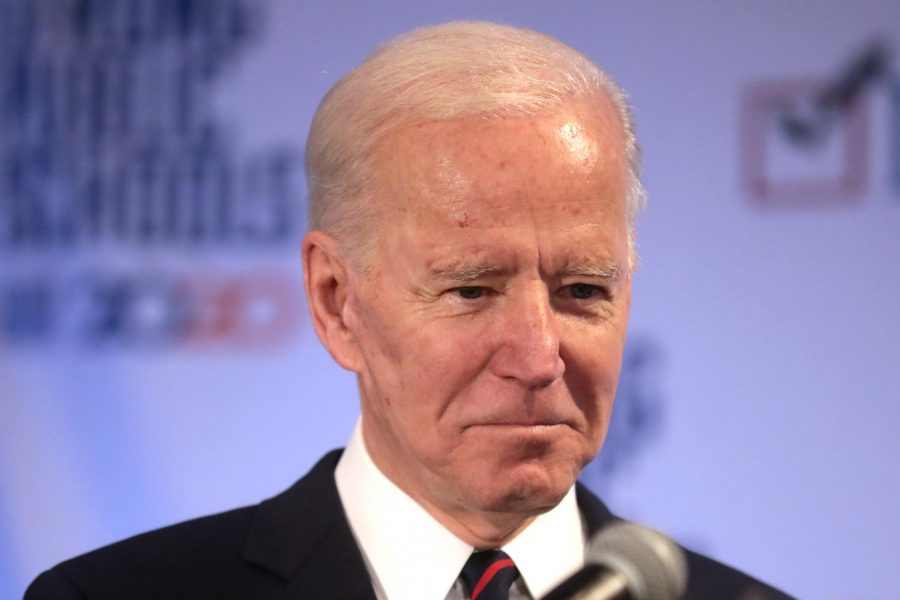OP-ED: 2020 Election Teaches Democrats Centrism is not Safe
November 19, 2020
In the aftermath of the 2016 election, we asked ourselves how Donald Trump, a reality show host, who had repeatedly made offensive racist and sexist comments – comments that would have spelled political death for most candidates – beat Hillary Clinton, a highly experienced political insider? And how could the polls have been so off? At the time, there was an easy answer: the 2016 election was unique. Hillary Clinton was an especially hateable candidate, with her share of political missteps, baggage from her husband’s scandal, and status as a woman. Donald Trump appealed to the political zeitgeist, as “PC culture” was on the rise and people wanted to shake up the system. Essentially, 2016 was dubbed a fluke. But the closeness of this year’s election challenges that view, even though President Trump lost.
This year, the polls once again predicted that Trump would lose by a wide margin. On Nov. 2, the day before the election, the website FiveThirtyEight gave Biden an 89 percent of winning the election, and nearly every other major poll predicted a comfortable Biden victory. This type of certainty appeared to be justified by other polls that showed that President Trump was faulted for mishandling the COVID-19 pandemic, resulting in over 230,000 deaths and a disastrous economy, with enormous unemployment, many restaurants having to shut down permanently, major retail stores, such as J. Crew and Neiman Marcus filing for bankruptcy, and hotels, airlines and gyms badly hit.
In fact, the polls were so confident that Biden would win that many projections showed traditionally Republican-leaning states like Arizona, Georgia, Texas, and North Carolina flipping Democrat. While Biden prevailed in both Georgia and Arizona by a small margin, Texas and North Carolina remained comfortably Republican, upsetting the overwhelming optimism among Democrats which was worsened by Florida going for Trump. Election day, which had been anticipated with excitement since 2016 by Democrats, extended to several days of nail biting, anxious, constant refreshing of the electoral map, and furious tweeting. In other words, it was close – closer than anyone expected.
Further, despite the GOP’s obvious ties to Trump’s sinking administration, the Republicans were able to flip several Democratic House seats, and, as of now, still maintain control of the Senate. This has left Democrats reexamining their path forward.
After their devastating loss in 2016, the Democratic Party became convinced that the key to defeating Trump come 2020 was to put up a safe, centrist candidate who could appeal to moderate Republicans. This led to plans designed to block progressive Democratic presidential candidates like Bernie Sanders, as well as progressive House and Senate candidates like Representative-Elect Jamaal Bowman.
In the case of Bowman, for example, the Democratic party establishment, including Speaker Nancy Pelosi and Governor Andrew Cuomo supported a moderate Democrat and 16th term incumbent, Eliot Engel, of New York’s 16th Congressional District, against Bowman in the primaries. However, Bowman, who ran on a progressive agenda, which included support for the Green New Deal, criminal justice reform and Medicare for All, defeated Engel in the primaries and then his Republican challenger for the House seat in November’s election.
Biden did indeed win, but just barely; he won each of Arizona, Georgia, Pennsylavania and Wisconsin by less than one percent of the vote. Biden’s narrow victory calls into question whether fielding a moderate candidate was indeed the best approach. Bowman, for example, won his race. And while Sanders was criticized by Biden and other top Democrats for his Medicare for All plan, in this election Democrats who supported Medicare for All tended to win reelection, and Democrats who opposed it were more likely to lose their congressional seat to a Republican. Additionally, progressive policies like the legalization of marijuana and a $15 minimum wage won in statewide referendums.
Further, the idea that Biden’s status as a moderate Democrat would attract votes from moderate Republicans didn’t play. According to exit polls, only six percent of self-identified Republicans voted for Biden, compared to four percent who voted for Hillary Clinton in 2016. The Democrats were so concerned with winning Republican support that donors and PACs gave tens of millions to the Lincoln Project, an anti-Trump Republican PAC. But Biden’s win did not come from the few moderate Republicans that flipped for him, but rather from grassroots organizing among left-wing voters, like Stacey Abrams’s push to increase turnout in Georgia.
So focused on winning moderates, Biden and the Democrats took for granted that minority and low-income voters, groups that traditionally vote Democrat, would show up for him. But this confidence wasn’t entirely justified. President Trump, who refused to condemn white supremacy in a debate with Biden, won a higher share of non-white support than he did in 2016. He also doubled his LGBTQ+ support from 2016.
The central point is that putting up a moderate candidate, like Biden, with the aim of winning some Republicans might work sometimes, as it did this year, with Biden winning small margins in enough states to carry the day. But this is a strategy that just leaves too much to chance. Biden barely won the four crucial states that delivered him the electoral victory. And it is not obvious that this is the best strategy going forward. While many Democrats have blamed progressives for their narrow victory, Alexandria Ocasio Cortez reminded them of success among progressive candidates, like herself.
Moderate Democrats might respond that the fact that Cortez prevails in New York City does not change the fact that a progressive agenda will hurt Democrats in other parts of the country, with some saying that Democrats should never use the word “socialism.” But it is not entirely clear that that is the case. A recent poll showed that the socialist label does not carry as much negative weight as many assume, and that Medicare for All – a plan often labelled as socialist – is embraced by a majority of the electorate.
The real issue is not so much that progressive ideals are unpopular, but that the Democrats failed wholeheartedly to embrace and explain those ideals. As a result, they let the Republicans paint a false caricature of what they mean. Trump was particularly adept at advancing a parade of horribles: the Democratic plan to combat climate change was transformed by Trump into one advocating the elimination of windows in buildings, even though neither Biden’s plan nor the Green Deal Deal even mention windows; the Democratic plan to bring racial justice to the housing market was recast by Trump into one endorsing the destruction of the suburbs, even though it does no such thing; Medicare For All was transformed by Trump into the first step in a Democratic plan “to model America’s economy after Venezuela,” bringing “suffering, misery and decay,” even though “Medicare For All” resembles Canada’s national health insurance program and does not even go as far as the National Health Service of the United Kingdom, and even though neither Canada nor the United Kingdom could be characterized as “miserable” places to live.
The Democrats should put up a more progressive candidate – someone who runs on a platform that promises fundamental, progressive change, for example, eliminating medical debt. There is no doubt that this might turn off some moderate voters, but I believe this would be more than offset by the excitement it would generate among those who actually want to see real change and by new voters attracted to a progressive agenda once they see past the Republican caricature of it. Indeed, this approach might draw back into the Democratic tent working-class voters who went for Trump because he appeared to speak to their grievances.
There is always a fear that the adoption of a more progressive agenda will alienate some voters, who might view it as extremist. But, in some ways, you don’t get more extreme than President Trump, who, as a candidate and as President, constantly made offensive racist comments, for example, about Mexicans being “rapists,” who refused to condemn white supremacy, who pursued a policy of separating children from their parents, and who poked fun at people wearing masks. Yet over 71 million people voted for him this year – eight million more than when he first ran. Trump shows that, while extremist views might repel some voters, they also attract many others.
By the same token, you don’t get much more moderate than Joe Biden. He is a relatively palatable candidate, who is well-known to the American people, having been a fixture on the political scene for some forty years. But the very fact that Biden – who is known for being a moderate and is generally viewed favorably – barely won against Trump does raise a question over the strategy of pursuing moderation.
As the Democrats move forward, they must learn from both 2016 and 2020. Trump’s election was not a fluke. He came close in this election, despite his bungling of the response to COVID-19, four years of continual lies, and racist dog whistles. The Democrats would do well to strengthen their own base, rebuild party unity, put forth progressive policies and candidates that inspire enthusiasm in voters, instead of advancing an unexciting centrism and and hoping voters show up anyway, and use those same progessive policies to attract the working class voters who sided with Trump in both of the last elections.








